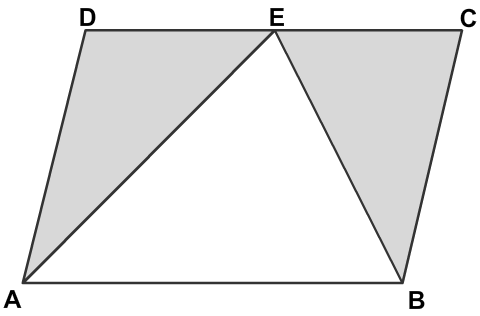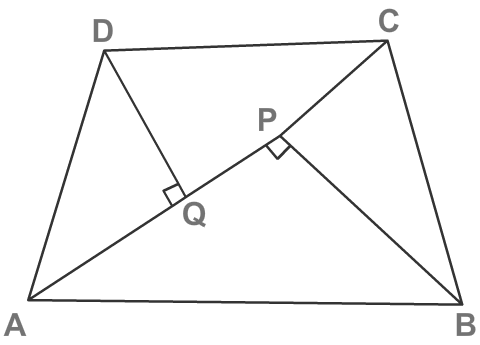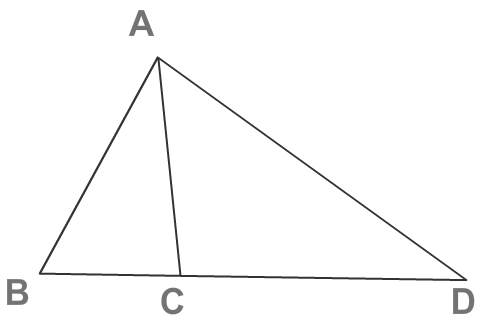Students and Teachers Forum
Given:∆ABE and //gm ABCD are on the same base AB and between the same parallels AB and DE. To prove:∆ABE = ½ of //gm ABCD in area Construction:From A, draw AF // BE meeting DF and .....
Given: ABCD is a parallelogram and P is any point inside it. AP, BP, CP and DP are joined. To prove: ∆APB + ∆CPD = ∆APD + ∆BPC Construction: Draw EPF ⊥ DC and AB & draw GPH ⊥ BC and .....
Given: ABCD is a trapezium. P is any point on diagonal BD. To prove: ∆APD = ∆CPD Construction: Draw EPF //BC//AD and GPH//AB//DC. Proof: Statements Reasons 1. ∆ADB = ∆BCD ∆DGP = .....
Given, Base of rhombus (AB) = (BC) = 8 cm Altitude (DE) = 3 cm. We know, Area of the rhombus (A) = base (AB) ⨉ height (DE) .....
Given: Para. ABCD and ∡ABE are standing on same base AB and between same parallels AB//DC. To prove: Area of Para. ABCD = 12 of Area of .....
The median of a triangle divides a triangle into two equal .....
Given: ABCD is a trapezium with AB//DC. E and F are the points on BD and AC respectively such that EF//AB or DC. To prove: ∆AOE = ∆BOF in area . .....
Given: Parm. ABCD and Parm. BCEF are standing on same base BC and between same parallels AF//BC. To prove: Area of Parm. ABCD = Area of Parm. .....
Given: Parallelogram ABCD and parallelogram ABEF are in standing on the same base AB and between the same parallels line FC//AB. To Prove: .....
Given: Para. WXYZ and △PXY are standing on same base XY and between same parallels WP//XY. To prove: Area of Para. WXYZ = 1/2 of Area of .....
Solution: Given, Area of parm. ABCD = 48 cm2 Altitude of DM on side AB (h1) = 6 cm .....
Given, Base of the parallelogram (b) = 6 cm Area of the parallelogram (A) = 24 cm2 We know, Area of a parallelogram (A) = base (b) ⨉ altitude .....
Given, Length of parallel sides, BC= 6.4 cm and (AD) = 5.6 cm Distance between the two parallels (DE) .....
Given, AD = 8 cm So, base (AB) = AD = 8 cm (measure of the sides of a square being equal) We know, Area of square (A) = l2 = (8 cm)2 .....
Given, Area of ∆ABE = 7 cm2 Area of parallelogram ABCD = 2 ∆ABE .....
Given: ∆ABC and DEF are on the equal bases BC and EF respectively and between the same parallels AD and BF. To prove: ∆ABC = ∆DEF in area. Construction: .....
Here, Given: DB ∥ CE To prove: Area of quadrilateral ABCD = Area .....
Given: ABCD is a parallelogram. E is any point on AB and DE and CB are produced to meet at F. CE and BD are joined. To prove: ∆BDF = ∆CEF .....
Given: ∡PQR and ∡SQR are standing on same base QR and between same parallels PS//QR. To prove: Area of ∡PQR = Area of ∡SQR. Construction: From point P, draw PX .....
We have, Area of parallelogram PQRS = height of parallelogram × base of parallelogram Or, 45cm2 = 9cm ⨉ base Or, base = .....
The area of parallelogram and rectangle standing on same base and between same parallels are .....
Given, Length of parallel sides, (AD) = 8 cm and (BC) = 12 cm Distance between the two parallels (DF) = 6 cm We know, Area of a trapezium (A) = ½ (sum of parallel sides) ⨉ distance between the .....
Given, Base (AB) = 7 cm Distance between the parallels (DM) = 4 cm. We know, Area of a parallelogram (A) = base (AB) ⨉ height (DM) .....
The diagonal of a parallelogram bisect it into ...2....... .....
Given: Parallelograms ABCD and EBCF are standing on the same base and between same parallel lines .....
i. Area of ABCD = 2 Area of ∆ADE [∵Area of parallelogram is double of area of triangle standing on same base and between same parallel lines] .....
i. Area of rhombus PQRS = 2 Area of ∆PQT [∵Area of parallelogram is double of area of triangle standing on same base and between same parallel lines] .....
i. Area of square ABCD = Area of parallelogram BCFE [∵ Area of parallelograms on the same base and parallel lines are equal and a square can be taken as parallelogram] .....
i. Area of parallelogram ABCD = AE.CD. ii. Area of parallelogram ABCD = AF.BC. iii. From i and ii, we get AE.CD = AF.BC or, 5 cm × CD = 8 cm × 10 cm .....
Given: PQ ∥ MN ∥ SR To prove: Area of ∆PSN = Area of ∆MQR. Proof: S.N Statements: S.N Reasons: 1 ∆PMN = ∆QMN 1 Triangles on the same base and between same parallel lines are equal in .....
Given: ABCD is a parallelogram and X is a point within it. To prove: Area of ∆ XCD + XAB = parallelogram ABCD ⨉ 1/2 Construction: PQ ∥ AB and CD is drawn through .....
Given: Area of parallelogram PQRS is equal to area of parallelogram LQMN. To prove: LR ∥SN Construction: L is joined with S and R is .....
Given: Q and R are mid-points of AC and AB respectively. To prove: Area of ∆PQR = 1/4 Area of ∆ABC Construction: B & Q are joined. Proof: S.N .....
i. Area of square ABCD = 12 AC2 = 12(6cm)2 .....
Given: ABCD is a parallelogram and E is any point on AB. DE and CB are produced to meet at P. AF and CE are joined. To prove: .....
Given: ABCD is a quadrilateral. AB is produced to E such that CE joined is parallel to DB. DE is joined. To prove: quadrilateral ABCD = ∆ADE. Construction:Join .....
Given, Base of parallelogram (DC) = 10 cm Distance between the parallels sides (h) = 8 cm. Now, Area of parallelogram ABCD = base (DC) ⨉ height (h) .....
Given, Base of parallelogram ABCD (DC) = (AB) = 8 cm Height of parallelogram ABCD (EF) = 6 cm. We know, Area of parallelogram ABCD (A) = base (AB) ⨉ height .....
Given, Base of parallelogram ABCD (AD) = 12 cm Height of parallelogram ABCD (FG) = 8 cm. We know, Area of parallelogram ABCD (A) = base (AD) ⨉ height (FG) .....
Given, Base of parallelogram ABCD (BC) = 12 cm Height of parallelogram ABCD (AE) = 9 cm. We know, Area of parallelogram ABCD = base (BC) ⨉ height (AE) .....
Given, Base of triangle BEC (BC) = 8 cm Height of triangle BEC (EC) = 3 cm We know, Area of triangle BEC (A) = ½ ⨉ base (BC) ⨉ height (EC) = ½⨉8 cm ⨉3 .....
Given: AB//DC//EF, AD//BE and AF//DE. To prove: Parm. DEFH = Parm. ABCD in area Proof: Statements Reasons 1.parallelograms. DEFH = parallelograms. DEGA 2.parallelograms. ABCD = parallelograms. .....
Area of ∆EBC = 12 × area of square ABCD =12 × (12×AC2) .....
Here, Construct a line BD. Given, 2DE=BC=12cm ==> DE = 6cm & BC= 12cm. Area of triangle BDC = 12 × DE × BC .....
i. Area of ∆ADM = 1/2 Area of parallelogram ABCD [∵ Area of triangle is half of area of parallelogram standing on same base and between same parallel lines] ii. Area of ∆ABN = 1/2 .....
Given, Area of //gm = 20cm2 Now, Area of Tr. ABE = 12 ⨉ Area of //gm = 10cm2. Area of shaded region = Area of //gm ABCD - Area of Tr.ABE .....
Area of ∆MNQ = 12×Area of para. MNOP = 12×MP×PR .....
Given: AC = 10cm, BP = 8cm and DQ = 4cm Area of qd.ABCD = ? We know, Area of qd. ABCD = 12 AC ( BP + QD) = 12 ⨉ 10cm ( 8cm + .....
Given, 4AM = 2CN = BD = 12 cm => AM=3 cm, CN=6 cm and BD=12 cm. Now, Area of the quad. ABCD = 12 × BD(AM+CN) .....
Here, ∆ABC = 15cm2, 2BC = CD. ∆ABD= ∆ABC + ∆AC D = 15cm2 + 2 ⨉15cm2 [ Since, 2BC = CD.] .....
.jpg)
.jpg)
.jpg)

(3).png)
(1).png)
(1).png)
.jpg)
.png)
.png)


.png)

.png)
.png)
.png)
(1).png)

.png)

.png)
